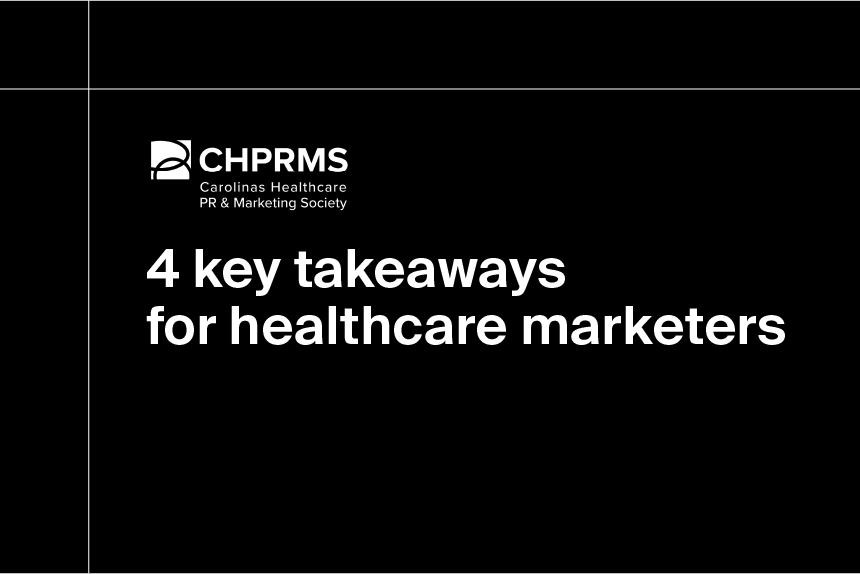Is your company’s marketing strategy ready for the new year?
If you’re looking at the calendar and wondering how it’s already November, here’s your wake-up call: 2026 is just around the corner, and there’s no better time to make sure your marketing operations are optimized for growth in the year ahead.
Don’t panic—we’ve compiled a simple checklist you can reference to close any potential gaps in your strategy. Whether you’re focused on selling medical devices or biopharmaceuticals, or attracting new patients to your practice, these tips will help you round out your marketing plan and head into 2026 with confidence.
1. Define and segment your core audience
Industry veterans and neophytes alike can benefit from revisiting this bit of Marketing 101 knowledge: You must know your audience and their needs in order to market your product or service successfully. And because your audience is probably not completely homogenous, you should separate them into smaller segments based on defining characteristics, needs, or behaviors.
If your company has been doing business for years, much of this groundwork is likely already complete. Still, the end of the year is a good time to revisit how you think about your audience in light of historical campaign performance. You can start with these questions:
- Which segments performed best/worst?
- Which channels are driving the most engagement?
- What messaging is working? What messaging is falling flat?
- How has your audience changed since it was last segmented?
- Do your historical marketing personas reflect your audience today?
By answering the questions above with sales and marketing data, you can fine-tune your audience targeting and segmentation approach. You may find little needs changing, or you may realize certain tactics simply aren’t working with specific segments.
Metrics are great, but they don’t tell the whole story. Don’t be afraid to check in with sales for a boots-on-the-ground perspective of your marketing strategy’s performance: Are they happy with the content and messaging provided by marketing, or are they going off script more often than not? If there’s any daylight between sales and marketing, now is the time to close it and realign your tactics.
2. Understand the purchasing landscape in your vertical
Healthcare purchasing is a notoriously slow process due to the variety of stakeholders involved. Selling a medical imaging software solution? You’re looking at months—maybe a year—of conversations, demos, and reviews with clinical, IT, procurement, and compliance teams, at least.
Some subverticals may find their efforts slowed even further in 2026, as new regulations, funding cuts, and general economic malaise apply friction and uncertainty throughout the purchasing process. As prospective buyers’ budgets tighten, you need to have a clear and up-to-date understanding of the expected length of your sales cycle to maximize revenue.
For instance, medical device and biopharma organizations should prepare for a slower review process as a leaner Food and Drug Administration drastically reduces its evaluation and premarket approval load. If the 2025 trend of grant termination continues into 2026, these companies may also need to factor in the risk of pausing or canceling clinical trials.
On the provider side, budgets continue to shrink as cuts to Medicare and Medicaid threaten to impact traditional revenue streams, leading care organizations to prioritize alternative service lines or outcome-based (rather than purely cost-based) purchases. And while COVID-19 might feel far away, provider procurement teams have not forgotten the impact of acute supply chain disruption and may increasingly value vendors that can demonstrate supply chain transparency, diversity, and resilience.
In any vertical, marketing teams can gain an edge by preparing for longer nurture cycles and creating content that highlights deep, real-world value generation. Sustained and value-oriented engagement strategies, rather than one-off low-funnel campaigns, will be key to marketing success in 2026.
3. Keep building trust, credibility, and thought leadership
In an era of lazily produced misinformation, malevolent disinformation, and AI-generated hallucinations, healthcare consumers are placing a higher premium than ever on trustworthiness, expertise, and transparency.
Patients want scientific rigor, transparent quality and outcome ratings, and success stories that highlight positive experiences. Providers want to work with peer-recommend experts who can demonstrate risk mitigation, regulatory compliance, and improved clinical outcomes.
As you look toward 2026, make trust, credibility, and thought leadership a cornerstone of your brand’s story. Case studies, ROI reports, data-driven whitepapers, and expert-led webinars are all examples of content that contribute to this story. A well-researched, routinely updated blog can also establish credibility and encourage engagement with your brand.
But you’ll need to go beyond content to really make an impact in the healthcare space. Partnering with key opinion leaders (KOLs) can not only boost the perceived expertise of your brand, but also increase the influence and reach of your engagement efforts and open doors to conference programming slots, new partnerships, and more.
If you don’t already have a KOL management strategy, start gathering data to map the KOL landscape in your therapeutic area. And if you’re a seasoned KOL manager, take the time to assess your current roster. You might find that your old standbys aren’t as influential as they once were, or that undervalued talent is beginning to show new potential. Medical and prescription claims, conference appearances, and social media activity can all provide insights into the impact of current and prospective KOLs.
4. Track digital trends to maximize omnichannel impact
The fundamentals of marketing haven’t changed much over the years, but the channels sure have diversified. It’s no longer enough to think of “digital marketing” as a monolith; instead, you’ll need to build out distinct—but interconnected—strategies for a variety of digital channels and content formats.
Refer to your core audience and its various segments and gather data on their digital behaviors. Are they finding solutions via organic search engine traffic, attending webinars to vet vendors, or opting for brands discussed among their LinkedIn networks?
An omnichannel marketing strategy aims to capture and connect all the channels through which your audience engages with your brand. Once you’ve identified these channels, make sure your strategy features content that’s proven to work within them. Video demos and testimonials (both long-form and TikTok-length), webinars and virtual events, infographics, and even the occasional meme could all be part of your content strategy, depending on the segment in question.
Of course, SEO and inbound marketing still matter, especially for provider brands. More than half of adult patients start their healthcare journeys online, so visibility and accessibility are key.
5. Be ready to demonstrate ROI
As we’ve learned from personal experience and conversations at the country’s largest healthcare marketing conference, marketing ROI is tough to pin down. Brand reputation, credibility, awareness, and loyalty are mercurial outcomes, and conversions can often be attributed to multiple channels or campaigns.
While it may be tempting to build marketing metrics around short-term wins and bottom-of-funnel outcomes, you’ll achieve greater impact—and earn the C-suite’s respect—by tying your team’s goals to wins across the sales pipeline.
Keeping in mind that conversions can often take between six months to a year in healthcare, plan to track and report on a variety of metrics in 2026 that represent the sales funnel from top to bottom:
- Qualified leads
- Content engagement and conversion
- Nurture time
- Pipeline velocity (qualified lead conversion time)
- Acquisition cost
- Customer lifetime value
You can cross-reference these metrics with a variety of additional data sources to develop deeper insights for key stakeholders. Social determinants of health (SDOH), consumer behavior, health interests, claims data, and referral pattern data can be used to measure the impact of marketing efforts within micro-segments or to demonstrate the influence of KOLs on patient and provider activity, for instance.
6. Make sure your data is up to date
Your organization’s historical marketing and sales data can tell you which tactics are working and which ones ought to be left in 2025. By incorporating a variety of external data sources into your marketing strategy, you can make even more informed decisions that preempt market trends and consumer behaviors rather than simply responding to them.
Here’s the challenge: There’s a universe of constantly evolving healthcare claims, reference and affiliations data, SDOH, and consumer behavioral data out there. If your dataset is limited, incomplete, or out of date, you’re only making things harder for yourself.
If your team is already working with market data, make sure it’s up to date and as complete as possible. This could involve a rigorous and time-consuming process of collecting, cleansing, appending, and securing a variety of publicly available datasets—requiring either a dedicated team or a part-time commitment of your current staff. Alternatively, you could opt to spend a little more, leave the data wrangling to a trusted vendor, and focus instead on using that data to accomplish your marketing goals.
Learn more
Want to see firsthand how the right data can transform your marketing strategy in 2026 and beyond? Sign up for a demo today, and we’ll show you how Definitive Healthcare helps healthcare organizations find their audience, engage them effectively, and achieve growth using data-driven insights and powerful analytics.




